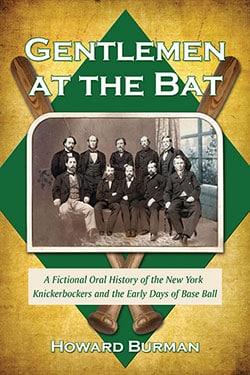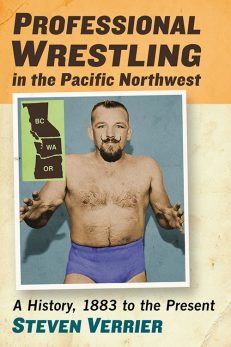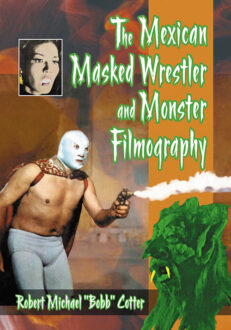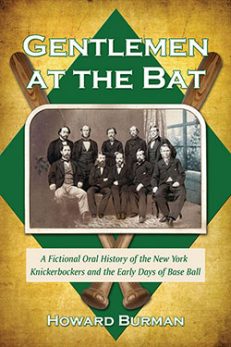Subtotal: $19.99
Gentlemen at the Bat
A Fictional Oral History of the New York Knickerbockers and the Early Days of Base Ball
$39.95
In stock
About the Book
Beginning in 1845, the New York Knickerbockers were the first fully organized base ball club to play the game with written rules similar to those used today. While they did not invent the game, they had an unparalleled role in stabilizing the playing rules and maintaining standards of conduct in a way that fostered an astonishing proliferation of players and clubs. Based on years of research and told in the style of oral history, this fictional work features all the principal figures from the Knickerbocker club, including Doc Adams, James Whyte Davis, Alexander Cartwright, William Wheaton, and Duncan Curry.
About the Author(s)
Bibliographic Details
Howard Burman
Format: softcover (6 x 9)
Pages: 364
Bibliographic Info:
Copyright Date: 2010
pISBN: 978-0-7864-4720-6
eISBN: 978-0-7864-5654-3
Imprint: McFarland
Table of Contents
A Note from the Author xi
Prologue: A Real Letter from Jim Davis to Edward Talcott 1
PART ONE: THE EARLY DAYS
1. On Beginnings 3
2. Meeting Doc and Poor Old Davis 4
3. And a Few Other Early Players 10
4. Gentlemen Playing All Manner of Games 14
5. A Connection Is Made Between Volunteer Fire Companies and Base Ball 19
6. Playing at Madison Park 24
7. Moving to Sunfish Pond 26
8. On the Move Again 29
9. Alick Makes a Suggestion 41
10. The Idea of Clubs 46
PART TWO: ORGANIZING THE CLUB 1845
11. Recruiting Members 51
12. Writing Rules 52
13. Gentlemen Inventing a Club 53
14. A Trip Across the River 66
15. Playing the First Games as the Knickerbocker Base Ball Club 69
16. Other Clubs, Other Games 72
17. Can They Carry On? 76
PART THREE: FIRST FULL SEASON 1846
18. An Important Decision 79
19. The First Match Game 81
20. Returning to Club Games 87
PART FOUR: STRUGGLE FOR SURVIVAL 1847–1849
21. The Winters Between 91
22. Struggles for Survival 95
23. On Operating a Gentlemen’s Club 96
24. Games Amongst Members 98
25. Doc Invents a New Position 100
26. Sporting New Uniforms 102
27. On Crowds and Riots 103
28. Of Bats and Balls 104
29. Printing the Rules 106
30. Going for the Gold 108
PART FIVE: THE NATIONAL GAME 1850–1854
31. Members Old and New 113
32. Base Ball, Base Ball, Base Ball 115
33. Return to Playing Other Clubs 119
34. On Matters Political 122
35. Dinners and Diversions 123
36. The National Game 124
37. Healthy Bodies, Healthy Minds 127
38. Good Players 131
39. Spectators 133
40. The Umpire Issue 135
PART SIX: BASE BALL FEVER 1855–1857
41. The Fever Spreads 139
42. Club Squabbles 141
43. Time to Organize 144
44. To Plan a Convention 145
45. The First Meeting 146
46. The Rules Committee 148
47. Recommendations 152
48. Playing the Fly Rule 153
49. On Maintaining Standards 154
50. First Nine Matches 155
51. Challenges 158
52. Women at the Games 159
53. Papers Taking Note 160
54. The Changing Game 162
55. New Equipment 165
56. The Pennant 166
57. An Impediment? 168
PART SEVEN: THE GREAT BASE BALL MATCH 1858
58. The Second Convention 171
59. The National Association 173
60. Another Rules Committee 175
61. A Symbol 178
62. Laying Plans 179
63. To Play or Not 183
64. The Day Approaches 184
65. The First Fashion Course Game 186
66. Aftermath of the Game 189
67. Getting Even 191
68. Rubber Match 192
69. Praise and Complaints 196
70. Season’s Play 197
PART EIGHT: AN ILL WIND 1859–1860
71. Beginning of the End 203
72. Going National 206
73. Sunday Play 209
74. Chadwick’s Guides 211
75. Out-of-Control Cranks 212
76. The Spectre of Professionalism 214
77. To Be Competitive 216
78. On Running a Club 218
79. Other Clubs to the Forefront 223
80. Of Bounders and Flys 224
81. Banning Entertainments 228
82. A New Park 229
83. Rule Changes 231
PART NINE: PLAYING THROUGH THE WAR 1861–1865
84. Things Unravel 235
85. Membership Matters 240
86. Maintaining Control 242
87. Creeping Commercialism 244
88. How They Played 249
89. Other Clubs’ Matches 252
90. Down to a Few 254
PART TEN: COMMERCIALISM 1866–1870
91. Base Ball Mania 259
92. Paid to Play 260
93. To Distinguish Between Amateur and Professional 262
94. All-Professional Clubs 264
95. A Question of Race 269
96. Leaving the Association 271
97. On Their Own 273
98. Dirty Dealings 276
99. Gate Money Principles 278
100. Difficult Times for Davis 281
101. Collapse of the Association 282
PART ELEVEN: AMATEURS AND PROFESSIONALS 1871–1875
102. Red Stockings Reversal 285
103. All-Amateur Association 286
104. Blurring the Lines 295
105. The Professionals Regroup 299
106. Club Doings 304
107. Chicanery on the Field 313
108. Tinkering with the Rules 314
109. Availability of Goods 317
110. On Curvers and Long Throws 319
111. Celebrating Davis 321
PART TWELVE: NATIONAL LEAGUE 1876–1879
112. A New Approach 329
113. Suspicions 331
114. Changes 333
115. Old-Timers 334
116. New Amateurs 337
117. And Then There Was One 338
PART THIRTEEN: THE END 1880–1882
118. Final Days 341
119. A Quiet End 346
Epilogue 349

 Reading American Horror Story
Reading American Horror Story 




